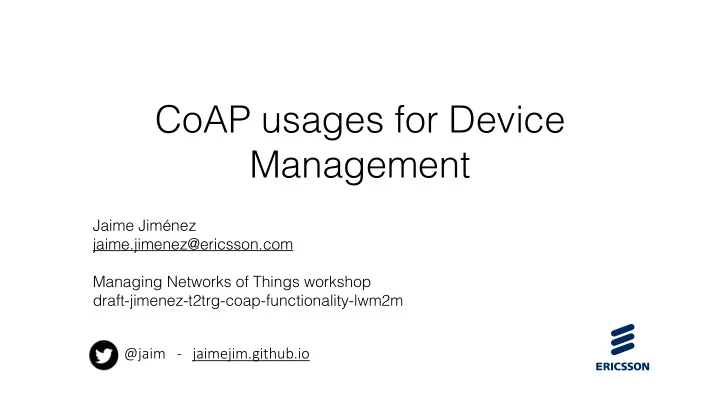

CoAP usages for Device Management Jaime Jiménez jaime.jimenez@ericsson.com Managing Networks of Things workshop draft-jimenez-t2trg-coap-functionality-lwm2m @jaim - jaimejim.github.io
Constrained Application Protocol (CoAP) • It is a RESTful protocol for constrained devices and networks, very similar to HTTP. Client/server & Request/Response - GET, POST, PUT, DELETE but also PATCH, iPATCH, FETCH Methods. - Same concepts (Media types, URL, URN…) - • The well-known URI - GET coap://[ip6address]/.well-known/core • IPv6 oriented (using 6LowPAN) - IP Multicast support 2
Constrained Application Protocol (CoAP) • Resource discovery via the Resource Directory (RD) • Compact 4-byte Header • Can run on UDP or SMS - Reliability is ensured by using with different message types: ‣ Confirmable (CON), non-confirmable (NON), acknowledgement (ACK) and reset (RST). • TCP currently being standardised. • Observe/Notify, adding an “observe” flag in the CoAP GET Request - Introduces a Publish/Subscribe model for constrained devices. • Facilitates new ways of interacting with devices and managing them CoMI/CoOL - LWM2M - 3
Constrained Management and Objects Language (CoOL/CoMI) • Describes a management function set adapted for constrained devices and constrained networks using YANG. • Interactions with objects use CoAP a application protocol. • Payloads are encoded in CBOR data format. 4
Constrained Management and Objects Language (CoOL/CoMI) • Similar to RESTCONF but: uses CoAP/UDP as transfer protocol. RESTCONF uses HTTP/TCP. - uses YANG-CBOR as payload format. RESTCONF uses YANG-JSON or YANG-XML. - CoMI encodes YANG identifiers as numbers, where RESTCONF encodes them into - strings (WIP). CoMI uses the methods FETCH and iPATCH, not used by RESTCONF (because HTTP - does not have that) RESTCONF uses the HTTP methods HEAD, and OPTIONS, which are not used by CoMI - (because CoAP does not have that). YANG used as modelling language but no specific data model (WIP). - … and many more at https://tools.ietf.org/html/draft-vanderstok-core-comi-10#page-7 - 5
OMA Lightweight M2M (LWM2M) • Management Interfaces for CoAP. Bootstrap: bootstrapping and upgrading a device. - Registration: taking a device into a logical group. - Device Management: by writing / creating objects inside the device. - Information Reporting: reading objects inside a device. - • LWM2M defines the Object Model. - Objects can correspond to sensors or actuators. - Defines data model but has no modelling language (XML kinda). 6
OMA Lightweight M2M (LWM2M) CoAP Client Objects LWM2M Objects Objects CoAP Server Server Objects LWM2M Device Management Information CoAP Service Reporting Enablement Bootstrap Client DTLS Server Registration SMS LWM2M Bootstrap on-Smartcard CoAP Client Client UDP SMS SmartCard CoAP Server LWM2M Architecture LWM2M Device Stack 7
LWM2M Interactions OMA LWM2M Specification Objects Objects Objects Objects Device Objects Objects Objects Objects LWM2M LWM2M GW LWM2M Device LWM2M LWM2M Server Bootstrap Server Device Objects Objects Objects Objects LWM2M LWM2M Device Server (SMS) Objects Objects Objects Objects 8
Possible LWM2M Additions 1. Device and Manager configuration. Currently covered by LWM2M. • [I-D.ietf-core-coap-tcp-tls] outlines the changes required to use CoAP over TCP, TLS, and WebSockets transports. • [I-D.ietf-core-object-security] For systems in which endpoints work behind a gateway or use LWM2M for managing the gateways, it might be good to implement other types of cryptographic protection than TLS/DTLS. • [I-D.ietf-core-etch] Support for features like PATCH/FETCH could be greatly beneficial for things like firmware upgrade or observing relatively large sets of resources. 9
Possible LWM2M Additions Objects ETCH Objects Objects Objects Device OSCOAP TCP/TLS Objects Objects ETCH Objects Objects LWM2M TCP/TLS TCP/TLS LWM2M GW LWM2M Device LWM2M LWM2M Server Bootstrap Server Device Objects Objects Objects ETCH Objects LWM2M LWM2M Device Server (SMS) Objects Objects Objects Objects 10
Possible LWM2M Additions 2. Device to Device configuration. • [I-D.ietf-core-resource-directory] CoAP’s in-built discovery would be beneficial to support cases in which devices talk to each or in which a more autonomous management approach is preferred. For now devices under the same subnet can use IP multicast as expressed on [RFC7390] and through /.well-known/core. Devices would support CoAP Observe [RFC7641] between each other in order to subscribe to updates from one another. • [I-D.ietf-ace-oauth-authz] could be used as security framework and the LWM2M Server would act as Authorization Server. 11
Possible LWM2M Additions Objects Objects Objects Objects Device Objects Objects Mngmnt Objects LWM2M Objects Authz LWM2M GW LWM2M Device CoAP + Server Observe Objects Objects App Objects ? RD Objects ? RD Bootstrap Server Device Objects Objects Objects Objects LWM2M LWM2M Device Server (SMS) Objects Objects Objects Objects 12
Possible LWM2M Additions 3. Device to Application configuration. Including the aforementioned on (1) and (2). [I-D.ietf-core-http-mapping] in cases of phone talking to GW. GW should implement a HC proxy. 13
Possible LWM2M Additions Objects Objects Objects Objects Client Device Objects Objects Mngmnt HTTP Objects LWM2M Objects LWM2M GW LWM2M Device LWM2M LWM2M Server Objects Objects App Objects HC Objects CoAP + Bootstrap Observe Server Device Objects Objects Objects Objects LWM2M LWM2M Device Server (SMS) Objects Objects Objects Objects 14
LWM2M Data Model • [RFC6690] Web Linking. ObjectLinks (String<ObjectID:InstanceID>) are not sufficient to represent links between devices or applications. • Use unique ResourceIDs and register them to consistently use the same identifiers for the same resources. • Update the serialization format [RFC7049]. JSON can be greatly compressed to CBOR format. • A lot of work has happened on the Data Model space, perhaps it is time to revisit the Object Model. [IOTSI] 15
Assorted References REST https://www.ics.uci.edu/~fielding/pubs/dissertation/rest_arch_style.htm CoAP https://tools.ietf.org/html/rfc7252 CoRE Link-Format https://tools.ietf.org/html/rfc6690 CoAP Observe https://tools.ietf.org/html/rfc7641 CBOR https://tools.ietf.org/html/rfc7049 IOTSI https://www.iab.org/activities/workshops/iotsi/ IOTSU https://www.iab.org/activities/workshops/iotsu/ CoRE RD https://datatracker.ietf.org/doc/draft-ietf-core-resource-directory/ LWM2M https://github.com/OpenMobileAlliance/ CoMI https://tools.ietf.org/wg/core/draft-ietf-core-yang-cbor/ CoAP-SNMP Interworking https://tutcris.tut.fi/portal/files/1076133/lindholm_ventola_coap_snmp_interworking.pdf CoAP TCP+TLS https://tools.ietf.org/wg/core/draft-ietf-core-coap-tcp-tls/ IPSO http://ipso-alliance.github.io/pub/ LWM2M to YANG https://tools.ietf.org/html/draft-vanderstok-core-yang-lwm2m-00 OSCOAP https://tools.ietf.org/wg/core/draft-ietf-core-object-security/ CoAP for LWM2M https://tools.ietf.org/html/draft-jimenez-t2trg-coap-functionality-lwm2m 16
Recommend
More recommend